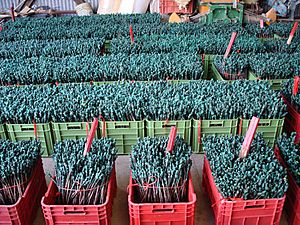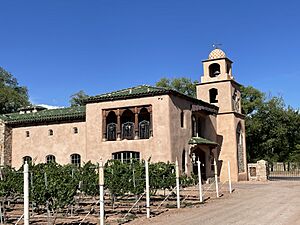New Mexico wine facts for kids
New Mexico has a long and interesting history of making wine! It's especially known for vineyards along the Rio Grande river, from the capital city of Santa Fe to Albuquerque and its nearby areas, and in valleys like the Mesilla Valley and Mimbres River valleys.
The very first wine grapes were planted in 1629 by two Franciscan friars, García de Zúñiga and Antonio de Arteaga. They planted them in what was then called Santa Fe de Nuevo México, which is now part of the Middle Rio Grande Valley AVA. Today, you can find wineries in the Middle Rio Grande Valley, the Mesilla Valley AVA, and the Mimbres Valley AVA.
| Wine region | |

Southern New Mexico vineyard
|
|
| Official name | State of New Mexico |
|---|---|
| Type | U.S. state |
| Year established | 1912 |
| Years of wine industry | 1629-present |
| Country | United States |
| Sub-regions | Mesilla Valley AVA, Middle Rio Grande Valley AVA, Mimbres Valley AVA. |
| Total area | 121,665 square miles (315,111 km2) |
| Size of planted vineyards | 1,200 acres (4.9 km2) |
| Grapes produced | Cabernet Sauvignon, Zinfandel, Sangiovese, Pinot noir, Ruby Cabernet, Nebbiolo, Dolcetto, Refosco, Barbera, Merlot, Petite Sirah, Syrah, Tempranillo, Cabernet Franc, Mourvèdre, Gewurztraminer, Chardonnay, Chenin blanc, Malvasia bianca, Muscat Canelli, Pinot gris, Viognier, Riesling, Muscat of Alexandria, Orange Muscat, Sauvignon blanc, Baco noir, Chambourcin, De Chaunac, Leon Millot, Marechal Foch, Seyval blanc, Vidal blanc, Villard blanc. |
| No. of wineries | Over 42 |
Wine growing became very popular after 1629. By 1880, grapes were grown on over 3,000 acres of land. Wineries were making over 1,000,000 gallons of wine each year! People at the time thought that grape growing would become a very important industry.
However, the wine industry in New Mexico faced challenges in the late 1800s. Flooding from the Rio Grande damaged many vineyards. Later, a time called Prohibition forced many wineries to close. During Prohibition, it was against the law to make or sell alcohol. Some wineries stayed open to make wine for religious ceremonies, especially for Catholic churches.
The modern New Mexico wine industry got a big boost in 1978. A government study encouraged winegrowers to use traditional New Mexican grapes. It also suggested working with wineries from Italy, Spain, and France to create new types of grapes. Today, New Mexico has more than 60 wineries. They produce about 900,000 gallons of wine every year.
Contents
New Mexico's Wine Story
How Wine Began Here
In 1598, the Spanish founded Santa Fe de Nuevo México. Spanish colonists, led by Don Juan de Oñate, settled in the upper valleys of the Rio Grande. Santa Fe, New Mexico was started in 1610. Franciscan priests came with the colonists to teach Christianity to the Native Americans and Hispanos.
The Franciscans needed wine for their daily religious services, called mass. Wine is an important part of these services. Getting wine shipped from Spain took many months. So, the friars needed a local source for their wine. This is why grapevines were first brought to New Mexico.
Smuggling Grapevines
Spanish law in 1595 actually made it illegal to send Spanish grapevines to other countries. This was to protect Spain's own farming industry. Spain earned a lot of money from selling wine to other countries. But the Franciscans decided to ignore this law. They secretly brought grapevines from Spain to New Mexico around 1629.
Fray García de Zúñiga and Antonio de Arteaga planted the first vines. They planted them at a Piro village, south of where Socorro is today. The grapevines they brought were a type called the Vitis vinifera Mission grape. This grape variety is still grown in New Mexico even now.
As the El Camino Real trade route grew, the city of Albuquerque became an important center. Wine was grown in many old towns around Albuquerque. These included places like Barelas, Corrales, Old Town Albuquerque, Sandia Pueblo, Los Ranchos, and Isleta Pueblo. This area is now known as the Middle Rio Grande Valley AVA.
Growing the Wine Industry
Between 1633 and 1800, the wine industry in New Mexico faced many challenges. Pueblo revolts and harsh winters sometimes harmed the grapes. But by the 1800s, New Mexico was becoming a strong wine-producing region.
By 1800, vineyards were planted from Bernalillo to Socorro in central New Mexico. They also stretched from Las Cruces to El Paso, Texas, in the southern part of the state. In 1850, New Mexico became a territory of the United States.
In 1868, Jesuit priests came to New Mexico. They brought their Italian winemaking skills and started a winery in 1872. By 1870, New Mexico made 16,000 gallons of wine. Just ten years later, in 1880, this number jumped to 908,000 gallons! The 1880 census showed that New Mexico had twice as much land planted with grapevines as New York. New Mexico was the fifth-largest wine producer in the entire nation.
New Mexico State University's Role
New Mexico State University has always helped with growing grapes and making wine in New Mexico. In 1920, when Prohibition began, Giovanni Giorgio Rinaldi took over Christian Brothers Winery in Bernalillo. He asked for help from professors at New Mexico A & M College, which is now New Mexico State University.
With their help, Rinaldi improved how grapes were grown. He also tried out different types of grapes and growing methods. For example, the Zinfandel grape, which came from Europe, was a result of these experiments. Rinaldi managed the winery until 1933, when Prohibition ended.
Challenges and a Fresh Start

In the early 1900s, the Rio Grande and its smaller rivers had many big floods. A major flood in 1926 damaged vineyards from Bernalillo to El Paso. Even though Prohibition started in 1919, and wine sales were limited, the amount of land used for grapevines actually doubled between 1920 and 1930.
However, the biggest flood of the century happened in 1943. It destroyed vineyards all over New Mexico. Many vineyards that had been making wine for fifty years were wiped out. The old commercial wine industry in New Mexico never fully recovered from these floods.
A New Beginning
By 1977, small commercial wineries started to open again. They made wine mostly from French-Hybrid grapes, which can handle cold weather well. These grapes grew successfully in northern New Mexico.
The first of these new wineries to open was La Viña Winery. It is now the oldest winery in New Mexico that has been open continuously. La Chiripada Winery, located in Dixon, New Mexico, planted its first vines in 1977. These were the first vines planted in Northern New Mexico since Prohibition. They released their first wine in 1981 and are still a family-run business today. La Chiripada Winery is the oldest continuously family-owned winery in New Mexico.
In 1981, a company started selling "vineyard" land near Engle. This attracted Hervé Lescombes and his family from Burgundy, France. Many other European investors followed, drawn by the cheap land and the chance to develop a new wine market. However, there wasn't enough water for irrigation, so many investors lost money.
Hervé Lescombes kept buying better land in southwest New Mexico and planted more vines in 1982. By 1984, St. Clair Winery opened its winery and first tasting room. It quickly became the largest winery in New Mexico. Today, Hervé Lescombes' sons, Florent and Emmanuel, own and run five locations across New Mexico. They have over 180 acres of family-owned vineyards.
Between 1982 and 1983, about 2,200 acres of vineyards were planted around Las Cruces. By 1986, there were 7,000 acres of vineyards across New Mexico. Although this number dropped to 700 acres by 1989, many more vineyards and large areas of grapes have been planted since then, continuing to grow the industry today.



